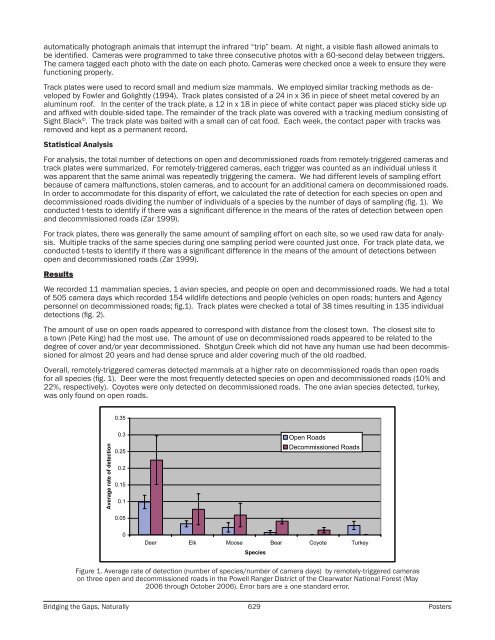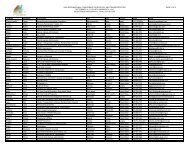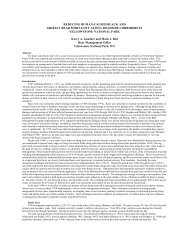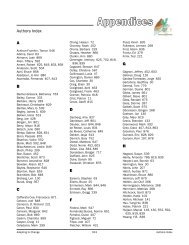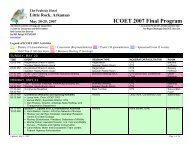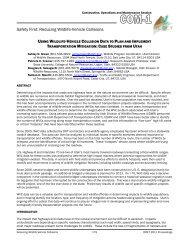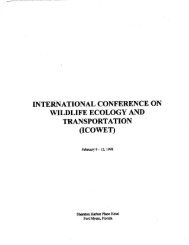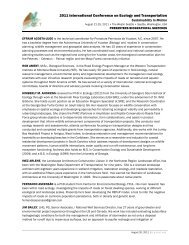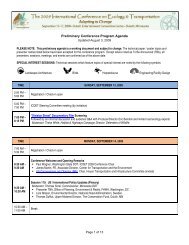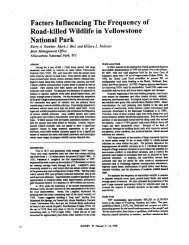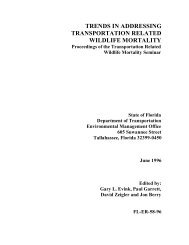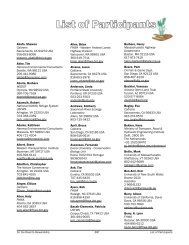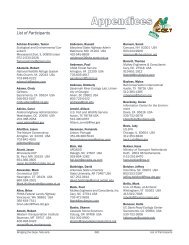Poster Sessions, pages 567-640 - ICOET
Poster Sessions, pages 567-640 - ICOET
Poster Sessions, pages 567-640 - ICOET
You also want an ePaper? Increase the reach of your titles
YUMPU automatically turns print PDFs into web optimized ePapers that Google loves.
automatically photograph animals that interrupt the infrared “trip” beam. At night, a visible flash allowed animals to<br />
be identified. Cameras were programmed to take three consecutive photos with a 60-second delay between triggers.<br />
The camera tagged each photo with the date on each photo. Cameras were checked once a week to ensure they were<br />
functioning properly.<br />
Track plates were used to record small and medium size mammals. We employed similar tracking methods as developed<br />
by Fowler and Golightly (1994). Track plates consisted of a 24 in x 36 in piece of sheet metal covered by an<br />
aluminum roof. In the center of the track plate, a 12 in x 18 in piece of white contact paper was placed sticky side up<br />
and affixed with double-sided tape. The remainder of the track plate was covered with a tracking medium consisting of<br />
Sight Black © . The track plate was baited with a small can of cat food. Each week, the contact paper with tracks was<br />
removed and kept as a permanent record.<br />
Statistical Analysis<br />
For analysis, the total number of detections on open and decommissioned roads from remotely-triggered cameras and<br />
track plates were summarized. For remotely-triggered cameras, each trigger was counted as an individual unless it<br />
was apparent that the same animal was repeatedly triggering the camera. We had different levels of sampling effort<br />
because of camera malfunctions, stolen cameras, and to account for an additional camera on decommissioned roads.<br />
In order to accommodate for this disparity of effort, we calculated the rate of detection for each species on open and<br />
decommissioned roads dividing the number of individuals of a species by the number of days of sampling (fig. 1). We<br />
conducted t-tests to identify if there was a significant difference in the means of the rates of detection between open<br />
and decommissioned roads (Zar 1999).<br />
For track plates, there was generally the same amount of sampling effort on each site, so we used raw data for analysis.<br />
Multiple tracks of the same species during one sampling period were counted just once. For track plate data, we<br />
conducted t-tests to identify if there was a significant difference in the means of the amount of detections between<br />
open and decommissioned roads (Zar 1999).<br />
Results<br />
We recorded 11 mammalian species, 1 avian species, and people on open and decommissioned roads. We had a total<br />
of 505 camera days which recorded 154 wildlife detections and people (vehicles on open roads; hunters and Agency<br />
personnel on decommissioned roads; fig.1). Track plates were checked a total of 38 times resulting in 135 individual<br />
detections (fig. 2).<br />
The amount of use on open roads appeared to correspond with distance from the closest town. The closest site to<br />
a town (Pete King) had the most use. The amount of use on decommissioned roads appeared to be related to the<br />
degree of cover and/or year decommissioned. Shotgun Creek which did not have any human use had been decommissioned<br />
for almost 20 years and had dense spruce and alder covering much of the old roadbed.<br />
Overall, remotely-triggered cameras detected mammals at a higher rate on decommissioned roads than open roads<br />
for all species (fig. 1). Deer were the most frequently detected species on open and decommissioned roads (10% and<br />
22%, respectively). Coyotes were only detected on decommissioned roads. The one avian species detected, turkey,<br />
was only found on open roads.<br />
Figure 1. Average rate of detection (number of species/number of camera days) by remotely-triggered cameras<br />
on three open and decommissioned roads in the Powell Ranger District of the Clearwater National Forest (May<br />
2006 through October 2006). Error bars are ± one standard error.<br />
Bridging the Gaps, Naturally 629 <strong>Poster</strong>s


